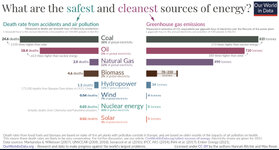bilby
Fair dinkum thinkum
- Joined
- Mar 6, 2007
- Messages
- 40,281
- Gender
- He/Him
- Basic Beliefs
- Strong Atheist
Not so much "The Remarkable Progress of Renewable Energy", as "The Remarkable Progress of Government Subsidy for Renewable Energy".
Throwing money at renewables will make them more widely available, but it won't make them a more sensible way to generate electricity. That would require some astonishing new physics to enable diffuse and intermittent energy sources to be collected and stored on a massive scale without the use of massive amounts of environmentally damaging materials extraction.
As we already have a non-polluting technology to make electricity continuously without this massive level of materials use, it seems more than slightly perverse to pursue solar and wind power for what are entirely ideological and irrational reasons.
The appeal to nature fallacy would remain fallacious even if it didn't imply strip mining of vast areas of the planet, dumping of huge volumes of toxic wastes, and generally fucking up the environment, just so a bunch of aging boomers with a phobia of the "N" word stemming from their Cold War memories can indulge their neo-Luddism.
We could just stop being stupid, and replace coal, oil, and gas with nuclear power. But people (particularly the Gas companies) prefer gas power (supplemented with a greenwash of largely ineffective, and hugely unprofitable, wind and solar power). Because humans are remarkable for their ability not to think things through.
Throwing money at renewables will make them more widely available, but it won't make them a more sensible way to generate electricity. That would require some astonishing new physics to enable diffuse and intermittent energy sources to be collected and stored on a massive scale without the use of massive amounts of environmentally damaging materials extraction.
As we already have a non-polluting technology to make electricity continuously without this massive level of materials use, it seems more than slightly perverse to pursue solar and wind power for what are entirely ideological and irrational reasons.
The appeal to nature fallacy would remain fallacious even if it didn't imply strip mining of vast areas of the planet, dumping of huge volumes of toxic wastes, and generally fucking up the environment, just so a bunch of aging boomers with a phobia of the "N" word stemming from their Cold War memories can indulge their neo-Luddism.
We could just stop being stupid, and replace coal, oil, and gas with nuclear power. But people (particularly the Gas companies) prefer gas power (supplemented with a greenwash of largely ineffective, and hugely unprofitable, wind and solar power). Because humans are remarkable for their ability not to think things through.

